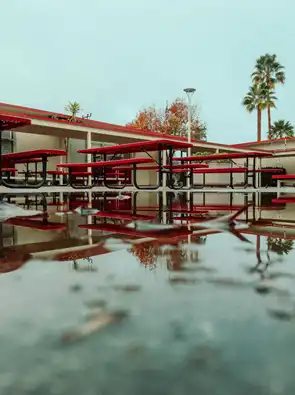Managing outdoor space maintenance in school settings, Education estate property management, Buildings systems
Managing Outdoor Space Maintenance in School Settings
29 May 2025
Outdoor areas in schools offer valuable opportunities for learning, recreation, and social interaction. These environments can influence students’ daily experiences just as much as classroom spaces do. Maintaining these areas is an ongoing responsibility that affects safety, hygiene, and the overall impression of the school. With careful attention to specific elements like seating, shade, greenery, and recreational surfaces, schools can keep their outdoor spaces clean, safe, and inviting for everyone.
Choosing and Caring for Picnic Tables
Picnic tables are a key part of any school’s outdoor setup. They serve as places for eating lunch, working on group projects, or simply relaxing during breaks. Selecting durable materials is a top priority. Metal and plastic-coated surfaces stand up well to harsh weather and heavy use. In particular, rubber-coated picnic tables offer a practical balance between comfort and resilience. They resist rust, are easy to wipe down, and reduce the chance of injury from sharp edges. Regular inspections help identify loose bolts or damage early, preventing minor issues from becoming major repairs.
Maintaining Safe Play Surfaces
Playgrounds require steady upkeep to avoid hazards. Fall zones around equipment should be checked weekly to confirm that materials like mulch or rubber tiles haven’t shifted. Surfaces need to stay level and well-cushioned to prevent injury. Periodic raking or top-ups may be necessary, especially after heavy use or poor weather. Paint on metal structures can peel or rust, so these areas benefit from seasonal touch-ups. Faded lines on sports courts can be re-marked during breaks to maintain visibility and safety.
Managing Grass and Natural Areas
Natural grass provides a soft and appealing setting for outdoor activities, but it demands routine attention. Mowing, fertilizing, and aeration help keep lawns healthy and usable. Overgrown grass can hide trash or uneven ground, increasing the risk of injury. Schools often find success with weekly mowing during the growing season and occasional overseeding to patch thin spots. Trees and bushes need trimming to avoid low-hanging branches or blocked paths. Litter collection should happen daily to maintain both appearance and hygiene.
Upkeep of Outdoor Furniture and Fixtures
Outdoor furniture and fixtures in school settings face constant exposure to sun, rain, wind, and frequent use by students. Over time, this leads to wear that can affect both appearance and safety. Benches, planters, fencing, signage, and trash bins should be inspected on a regular basis, not only for visible damage but for signs of long-term deterioration such as rust, splintering, or structural weakening. Painted metal may begin to flake or corrode, especially after winter or wet seasons, so annual touch-ups with weather-resistant paint can help extend the life of these items. Wooden furniture requires closer attention. Moisture can lead to swelling or rot, particularly where legs meet the ground or joints are not sealed properly. Sanding and sealing wooden surfaces once or twice a year can significantly improve their durability.
Pressure washing is a useful method for cleaning walkways, seating areas, and vertical surfaces like fences. This removes dirt, moss, and mildew that build up, especially in shaded or high-traffic zones. Walkways should be monitored for cracks or uneven sections that could become tripping hazards, with prompt patching or replacement scheduled during school holidays to avoid disruption. Trash and recycling bins need regular cleaning and disinfecting to prevent odor and pests, especially in warmer months. Their placement should support easy access while reducing clutter or overflow, particularly near lunch areas or entrances.
Protecting Shaded and Covered Areas
Shade structures such as pergolas, umbrellas, or covered pavilions contribute to comfort during warm months. Fabric canopies should be removed during the winter or checked regularly for wear. Metal frames might need tightening or rust removal. Drainage around these areas is crucial; pooling water can lead to slippery surfaces or flooding. Gutters and downspouts attached to any covers must remain clear to function properly. These shaded zones are often heavily used, making cleanliness and stability key.
Scheduling and Staffing for Effective Maintenance
Consistent outdoor maintenance depends on organized planning. Creating a rotating schedule helps divide tasks fairly among staff. Some jobs, like lawn care, may be outsourced, while others, like trash pickup or bench checks, stay in-house. Staff should know what to look for and who to report concerns to. Posting checklists in maintenance areas can help keep track of duties. Working this system into the school calendar, especially before breaks and new terms, prevents issues from piling up during busy times.
Outdoor spaces at schools require ongoing care to remain safe, functional, and welcoming. From picnic tables to play areas, each component brings its own set of challenges and benefits. By attending to details like surface materials, drainage, and furniture condition, schools can create an environment that supports both recreation and learning. A well-kept outdoor area reflects a school’s commitment to its students’ well-being in every season.
Comments on this guide to Managing outdoor space maintenance in school settings – Building Systems article are welcome.
Buildings
Wisdom of Choosing Aluminium Windows

image courtesy of article provider
Use of Aluminium in Architecture
Natural slate rainscreen cladding system
Building Articles
Comments / photos for the Managing outdoor space maintenance in school settings – property management in 2025 page welcome.






